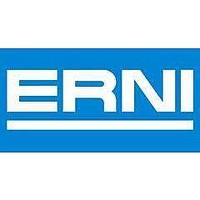103658 ERNI Electronics, 103658 Datasheet - Page 4

103658
Manufacturer Part Number
103658
Description
Manufacturer
ERNI Electronics
Type
D-SUB Moduler
Datasheet
1.103658.pdf
(22 pages)
Specifications of 103658
Gender
M
Body Orientation
Right Angle
Number Of Contacts
9POS
Product Depth (mm)
16mm
Operating Temperature Min Deg. C
-20C
Lead Free Status / RoHS Status
Compliant
General Information
The development of bus systems for industrial applications
began in 1983. To be more accurate, it was the use of serial
data transmission which brought about the breakthrough. In
1988, field bus systems were still new in industrial automation
and a great deal of effort was required to win customers. But
within a very short time, so-called field bus systems have gai-
ned acceptance to an extent that no one could have drea-
med of.
This has only been possible because customers have simply
been made aware of a clear product advantage. From then
on, it was no longer necessary to individually wire device for
device and signal for signal; instead so-called “bus nodes”
could be installed, which communicate with one another by
means of a 2-wire cable and pass on commands to the input
and output modules. In this way, installation expense and the
possibility of faults were considerably reduced. Added to this
are features such as remote diagnostics, parameter setting
and modularity, to name but a few. Of the multitude of field
buses that came onto the market, some have almost disap-
peared again. The large control system manufacturers are try-
ing to establish their systems in the marketplace through
so-called user organizations, e.g. PNO (Profibus User
Organization), CiA (CAN in Automation), SafetyBUS p
(SafetyBUS Club), and other marketing activities.
A fundamental difference is constituted by the different net-
work topologies. Hence, there are line, ring or star configura-
tions. All have their particular advantages and disadvantages.
Device hierarchies are also possible: master-slave systems or
multi-master systems.
A characteristic of the line configuration is that the bus must
be “terminated” by means of a resistor at the end of the line
in order to avoid effects such as reflections, which may inter-
fere with the communication.
Devices within the line are cabled by “looping through”. Here,
the T function, which enables the bus to operate when the
plug is removed, is of particular interest.
ERNI is currently concentrating on Profibus, CAN bus and
SafetyBus p versions where, at the same time, customer-spe-
cific solutions e.g. for Bitbus, Interbus, etc. also exist.
In the meantime, some bus systems have been internationally
standardized. The so-called physical layer is also defined in
these standards, which, among other things, specify the
cable, the connectors and the contact assignment. There are
still differences with regard to the protection class. Different
plug connectors are recommended depending on this. The
term “light duty” is used with IP 20 and “heavy duty” with IP
65/67.
4
Catalog E 074441
01/06
ERNI bus interface connector, ERbic for
short
The interface plugs of the ERbic line for various bus systems
offer different features and advantages. They are based on D-
Sub interface technology. All ERbics have compact external
dimensions. There are versions with horizontal and vertical
cable outlets.
Both pure node versions and pure termination versions are
available as well as nodes with a connectable termination
resistor. The node (without termination resistors) is used wit-
hin the length of a line and the termination (with termination
resistors) at the end of the line. The node with a connectable
termination resistor can be used anywhere. The latter is simp-
ly configured as a termination by changing the position of the
switch.
The housings of the pure terminations are a different color
than the nodes. The end of the line is therefore immediately
recognizable.
The bus systems are also different colors. The user can the-
refore easily find their way around within a system.
A T function is provided in all ERbics. A device can therefore
be changed while the bus is running. The types with a
connectable termination resistor are primarily suitable for
customers with reduced storage or when setting up, exten-
ding or converting large systems.
Certain types are reversed with regard to the face of the
connector, allowing the direction of the cable outlet to be
determined. This is achieved by a special pin arrangement in
the D-Sub connector.
However, the standard direction of the cable outlet is mat-
ched to the devices of the market leaders and should there-
fore be used for new designs.
A further outstanding feature is the termination technology.
Depending upon the type, ERbics are available with screw
terminals, cage-clamp terminals or IDC terminals.
Terminations using the Siemens FastConnect principle, for
example, are therefore possible.
The development of field buses in the direction of safety-rela-
ted applications is also satisfied by corresponding further
advancement of the ERbic line. There is a Profibus Ex i versi-
on, which was developed together with ABB, or a SafetyBus
p version for the Pilz company.
As an alternative to the plastic housing, the newly developed
ERbic MAX has recently been introduced to the market. This
has a metal housing and an axial cable outlet. It is particularly
suitable for harsh environments and offers space advantages
at the field device when several interfaces are present.
The metal housing guarantees optimum EMC.
Edition 4
www.erni.com












